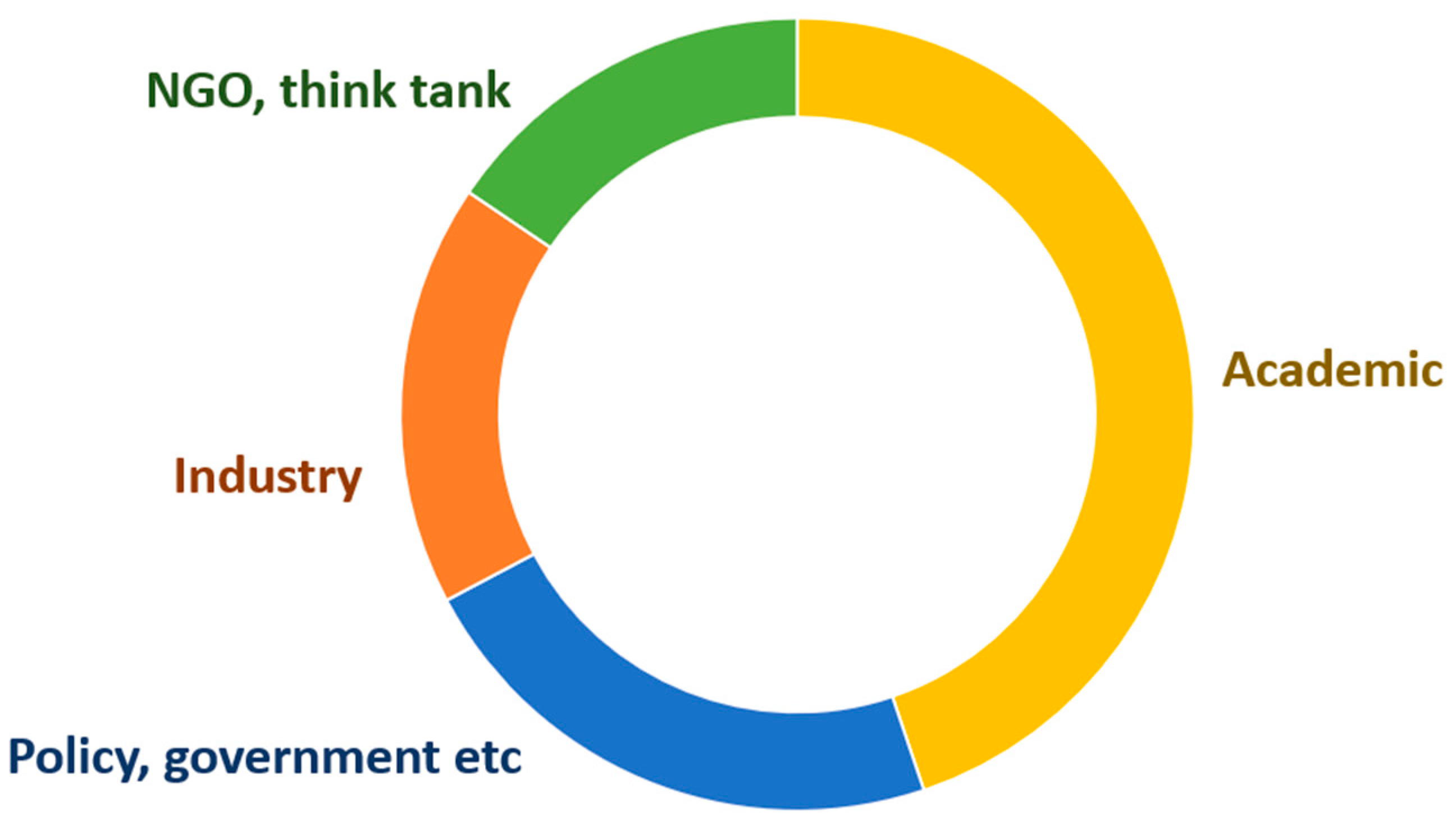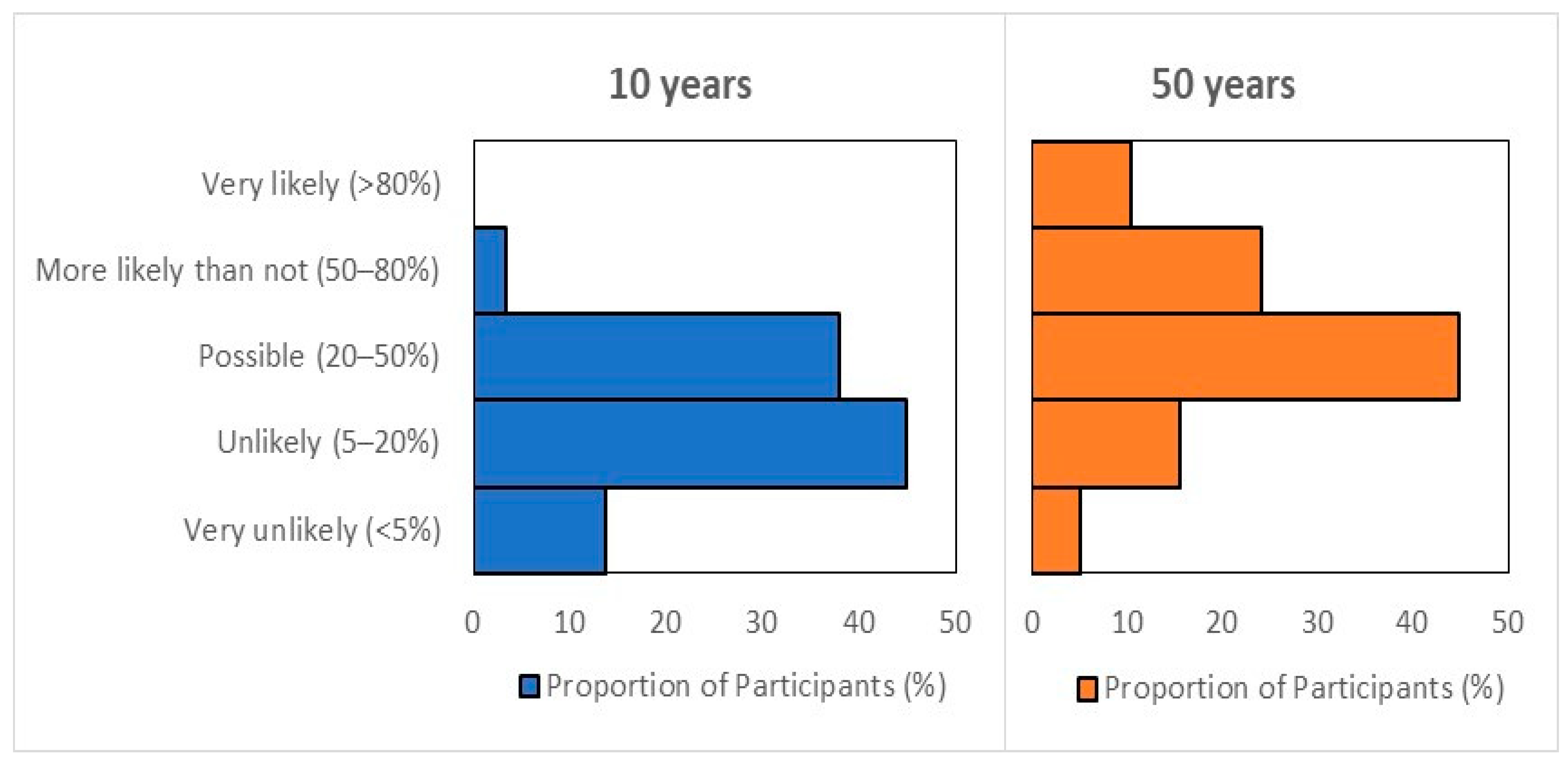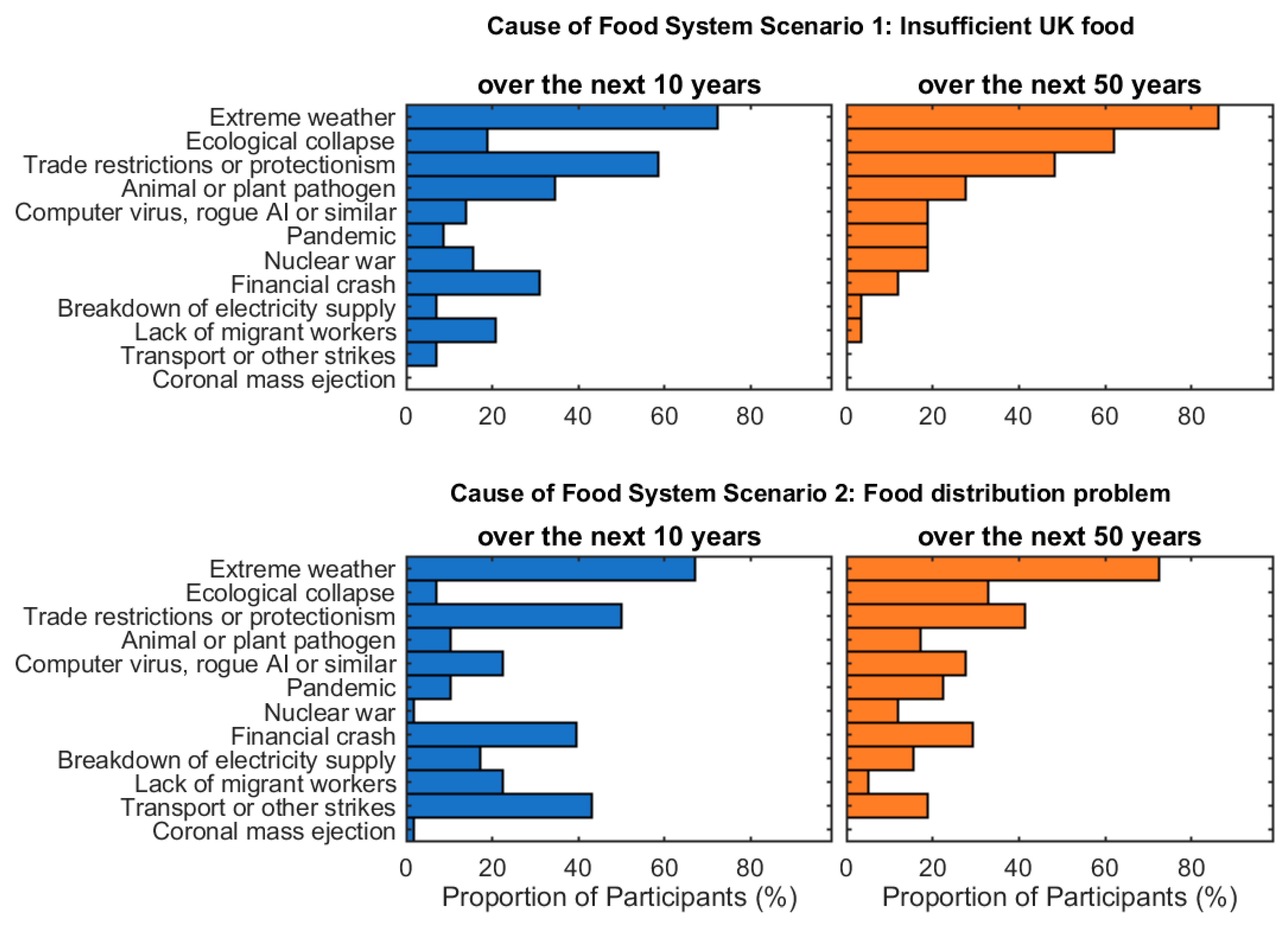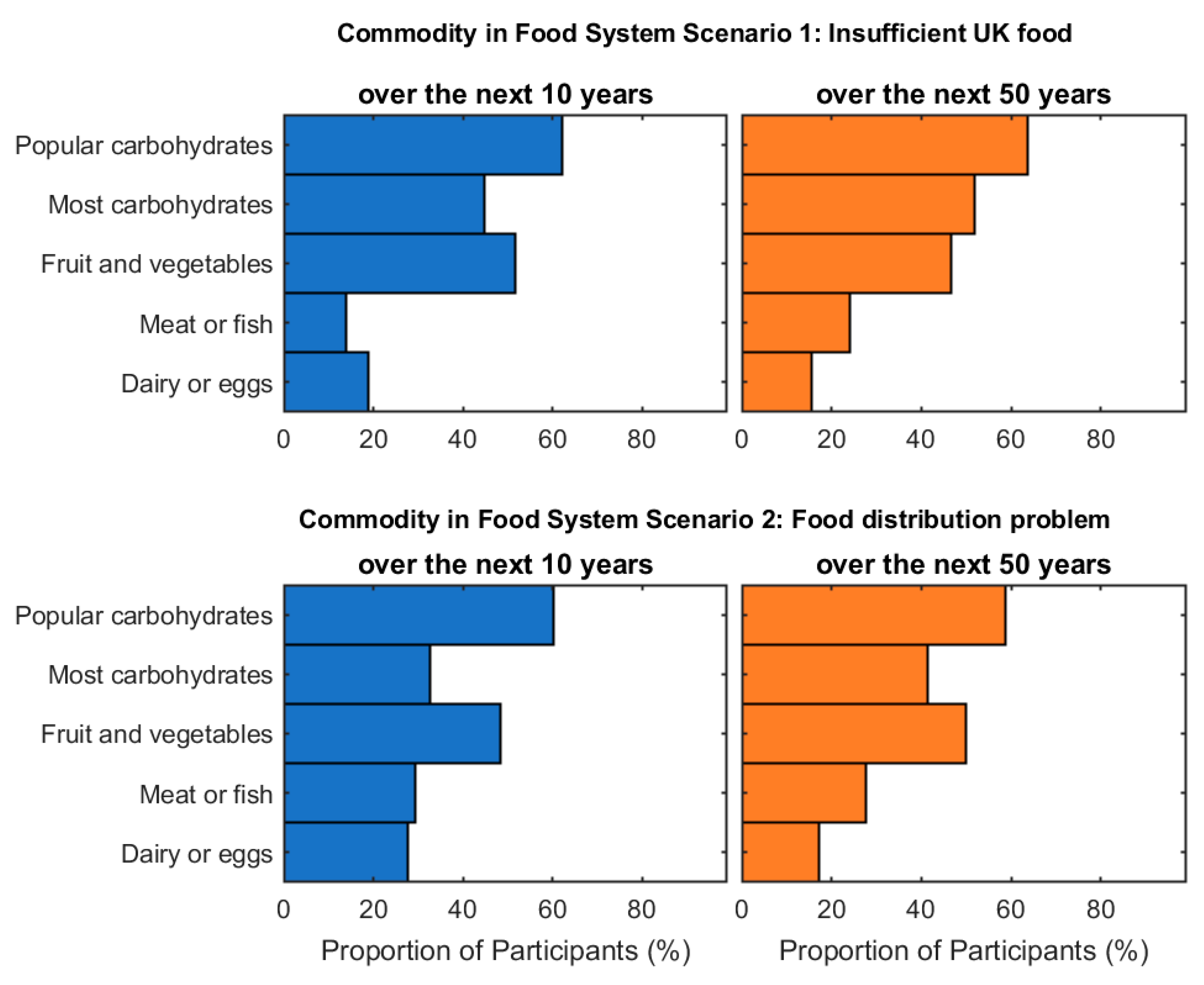Scoping Potential Routes to UK Civil Unrest via the Food System: Results of a Structured Expert Elicitation
Abstract
:1. Introduction
- Beyond the collective capability of governments and the private sector to control [7];
- Cause significant harm at the global scale, such as a large reduction in global population [8];
- Precipitate the failure of critical global systems, including the cluster of socio-technological systems sometimes called “human civilisation” [9].
2. Methods
Societal Event
3. Results
3.1. Causal Pathways Leading to Different Food System Scenarios
3.2. Developing Expanded Food System Scenarios
4. Discussion
5. Conclusions
Supplementary Materials
Author Contributions
Funding
Institutional Review Board Statement
Informed Consent Statement
Data Availability Statement
Acknowledgments
Conflicts of Interest
Appendix A. The Catastrophic Food System Disruption Expert Elicitation Survey
Appendix A.1. 10 Years
- Very unlikely (<5%)
- Unlikely (5–20%)
- Possible (20–50%)
- More likely than not (50–80%)
- Very likely (>80%)
- extreme weather (including storm surges, flooding, snow, drought)
- nuclear war
- trade restrictions or protectionism
- pandemic
- financial crash
- animal or plant pathogen
- ecological collapse
- computer virus, rogue AI or similar
- breakdown of electricity supply
- coronal mass ejection
- transport strikes
- lack of migrant workers
- popular carbohydrates (wheat/bread/pasta/cereal)
- most carbohydrates (including oats, potatoes, barley)
- fruit and vegetables
- dairy or eggs
- meat or fish
- extreme weather (including storm surges, flooding, snow, drought)
- nuclear war
- trade restrictions or protectionism
- pandemic
- financial crash
- animal or plant pathogen
- ecological collapse
- computer virus, rogue AI or similar
- breakdown of electricity supply
- coronal mass ejection
- transport strikes
- lack of migrant workers
- popular carbohydrates (wheat/bread/pasta/cereal)
- most carbohydrates (including oats, potatoes, barley)
- fruit and vegetables
- dairy or eggs
- meat or fish
Appendix A.2. 50 Years
- Very unlikely (<5%)
- Unlikely (5–20%)
- Possible (20–50%)
- More likely than not (50–80%)
- Very likely (>80%)
- extreme weather (including storm surges, flooding, snow, drought)
- nuclear war
- trade restrictions or protectionism
- pandemic
- financial crash
- animal or plant pathogen
- ecological collapse
- computer virus, rogue AI or similar
- breakdown of electricity supply
- coronal mass ejection
- transport strikes
- lack of migrant workers
- popular carbohydrates (wheat/bread/pasta/cereal)
- most carbohydrates (including oats, potatoes, barley)
- fruit and vegetables
- dairy or eggs
- meat or fish
- extreme weather (including storm surges, flooding, snow, drought)
- nuclear war
- trade restrictions or protectionism
- pandemic
- financial crash
- animal or plant pathogen
- ecological collapse
- computer virus, rogue AI or similar
- breakdown of electricity supply
- coronal mass ejection
- transport strikes
- lack of migrant workers
- popular carbohydrates (wheat/bread/pasta/cereal)
- most carbohydrates (including oats, potatoes, barley)
- fruit and vegetables
- dairy or eggs
- meat or fish
References
- Bostrom, N.; Cirkovic, M.M. (Eds.) Global Catastrophic Risks; Oxford University Press: New York, NY, USA, 2011. [Google Scholar]
- UK Government. High Impact Low Probability Risks: Blackett Review. GOV.UK. 2012. Available online: https://www.gov.uk/government/publications/high-impact-low-probability-risks-blackett-review (accessed on 29 November 2022).
- Posner, R. Catastrophe: Risk and Response; Oxford University Press: Oxford, UK, 2004. [Google Scholar]
- Wallace-Wells, D. The Uninhabitable Earth; Penguin Random House: London, UK, 2019; Available online: https://www.penguinrandomhouse.com/books/586541/the-uninhabitable-earth-by-david-wallace-wells/ (accessed on 29 November 2022).
- Sunstein, C.R. Worst-Case Scenarios; Harvard University Press: Cambridge, MA, USA, 2009. [Google Scholar]
- OECD. Emerging Risks in the 21st Century: An Agenda for Action. Organisation for Economic Co-Operation and Development. 2003. Available online: https://www.oecd-ilibrary.org/economics/emerging-risks-in-the-21st-century_9789264101227-en (accessed on 29 November 2022).
- Schoch-Spana, M.; Cicero, A.; Adalja, A.; Gronvall, G.; Kirk Sell, T.; Meyer, D.; Nuzzo, J.B.; Ravi, S.; Shearer, M.P.; Toner, E.; et al. Global catastrophic biological risks: Toward a working definition. Health Secur. 2017, 15, 323–328. [Google Scholar] [CrossRef]
- Cotton-Barratt, O.; Farquhar, S.; Halstead, J.; Schubert, S.; Snyder-Beattie, A. Global Catastrophic Risks 2016; Global Challenges Foundation: Stockholm, Sweden, 2016. [Google Scholar]
- Avin, S.; Wintle, B.C.; Weitzdörfer, J.; ÓhÉigeartaigh, S.S.; Sutherland, W.J.; Rees, M.J. Classifying global catastrophic risks. Futures 2018, 102, 20–26. [Google Scholar] [CrossRef]
- Baum, S.D.; Denkenberger, D.C.; Pearce, J.M.; Robock, A.; Winkler, R. Resilience to global food supply catastrophes. Environ. Syst. Decis. 2015, 35, 301–313. [Google Scholar] [CrossRef]
- Garnett, P.; Doherty, B.; Heron, T. Vulnerability of the United Kingdom’s food supply chains exposed by COVID-19. Nat. Food 2020, 1, 315–318. [Google Scholar] [CrossRef]
- Betts, R.A.; Brown, K. Technical Report of the Third UK Climate Change Risk Assessment (CCRA3). Prepared for the Climate Change Committee, London. 2021. Available online: https://www.ukclimaterisk.org/independent-assessment-ccra3/technical-report/ (accessed on 17 November 2022).
- From Farm to Fork: Rethinking Food and Drink Supply Chains—Part 2: The Food and Drink Industry. Lloyd’s Futureset. 2022. Available online: https://assets.lloyds.com/media/60e7d0b6-3702-4cf6-a819-2ba10d68f4d4/Lloyds-Futureset_From-farm-to-fork_The-food-and-drink-industry_Part-2.pdf (accessed on 21 July 2023).
- Hobbs, J.E. Food supply chains during the COVID-19 pandemic. Can. J. Agric. Econ. 2020, 68, 171–176. [Google Scholar] [CrossRef]
- Laborde, D.; Martin, W.; Swinnen, J.; Vos, R. COVID-19 risks to global food security. Science 2020, 369, 500–502. [Google Scholar] [CrossRef]
- Kornhuber, K.; Petoukhov, V.; Karoly, D.; Petri, S.; Rahmstorf, S.; Coumou, D. Summertime Planetary Wave Resonance in the Northern and Southern Hemispheres. J. Clim. 2017, 30, 6133–6150. [Google Scholar] [CrossRef]
- Lunt, T.; Jones, A.W.; Mulhern, W.S.; Lezaks, D.P.M.; Jahn, M.M. Vulnerabilities to agricultural production shocks: An extreme, plausible scenario for assessment of risk for the insurance sector. Clim. Risk Manag. 2016, 13, 1–9. [Google Scholar] [CrossRef]
- Bailey, R.; Wellesley, L. Chokepoints and Vulnerabilities in Global Food Trade. Chatham House. 2017. Available online: https://www.chathamhouse.org/2017/06/chokepoints-and-vulnerabilities-global-food-trade (accessed on 19 July 2023).
- Natalini, D.; Jones, A.; Bravo, G. Quantitative Assessment of Political Fragility Indices and Food Prices as Indicators of Food Riots in Countries. Sustainability 2015, 7, 4360–4385. [Google Scholar] [CrossRef]
- Hunt, E.; Femia, F.; Werrell, C.; Christian, J.I.; Otkin, J.A.; Basara, J.; Anderson, M.; White, T.; Hain, C.; Randall, R.; et al. Agricultural and food security impacts from the 2010 Russia flash drought. Weather Clim. Extrem. 2021, 34, 100383. [Google Scholar] [CrossRef]
- Di Capua, G.; Sparrow, S.; Kornhuber, K.; Rousi, E.; Osprey, S.; Wallom, D.; van den Hurk, B.; Coumou, D. Drivers behind the summer 2010 wave train leading to Russian heatwave and Pakistan flooding. NPJ Clim. Atmos. Sci. 2021, 4, 1–14. [Google Scholar] [CrossRef]
- Kornhuber, K.; Lesk, C.; Schleussner, C.F.; Jägermeyr, J.; Pfleiderer, P.; Horton, R.M. Risks of synchronized low yields are underestimated in climate and crop model projections. Nat. Commun. 2023, 14, 3528. [Google Scholar] [CrossRef] [PubMed]
- Kornhuber, K.; Coumou, D.; Vogel, E.; Lesk, C.; Donges, J.F.; Lehmann, J.; Horton, R.M. Amplified Rossby waves enhance risk of concurrent heatwaves in major breadbasket regions. Nat. Clim. Change 2020, 10, 48–53. [Google Scholar] [CrossRef]
- Malesios, C.; Jones, N.; Jones, A. A change-point analysis of food price shocks. Clim. Risk Manag. 2020, 27, 100208. [Google Scholar] [CrossRef]
- Clapp, J.; Moseley, W.G. This food crisis is different: COVID-19 and the fragility of the neoliberal food security order. J. Peasant Stud. 2020, 47, 1393–1417. [Google Scholar] [CrossRef]
- Vanhaute, E. From famine to food crisis: What history can teach us about local and global subsistence crises. J. Peasant Stud. 2011, 38, 47–65. [Google Scholar] [CrossRef] [PubMed]
- Chopra, S. Supply chain breakdown. MIT Sloan Manag. Rev. 2004, 46, 53–61. [Google Scholar]
- Hapgood, M.; Thomson, A. Space Weather: Its Impacts on Earth and Implications for Business. Lloyd’s. 2010. Available online: https://assets.lloyds.com/media/ec9c7308-7420-4f1a-83c3-9653b1f00a4c/7311_Lloyds_360_Space%20Weather_03.pdf (accessed on 19 July 2023).
- Noland, R.B.; Polak, J.W.; Bell, M.G.; Thorpe, N. How much disruption to activities could fuel shortages cause?—The British fuel crisis of September 2000. Transportation 2003, 30, 459–481. [Google Scholar] [CrossRef]
- Royall, F. The Gilets Jaunes Protests: Mobilisation without third-party Support. Mod. Contemp. Fr. 2020, 28, 99–118. [Google Scholar] [CrossRef]
- Coles, D.; Yu, D.; Wilby, R.L.; Green, D.; Herring, Z. Beyond “flood hotspots”: Modelling emergency service accessibility during flooding in York, UK. J. Hydrol. 2017, 546, 419–436. [Google Scholar] [CrossRef]
- Lang, T.; Millstone, E.; Lewis, T.; Marsden, T. Feeding Britain: Food Security after Brexit. Food Research Collaboration. 2018. Available online: https://foodresearch.org.uk/publications/feeding-britain-food-security-after-brexit/ (accessed on 19 July 2023).
- Hasnain, S.; Ingram, J.; Zurek, M. Mapping the UK Food System—A report for the UKRI Transforming UK Food Systems Programme. Environmental Change Institute. 2020. ISBN 978-1-874370-81-9. Available online: https://www.foodsecurity.ac.uk/wp-content/uploads/2009/10/Mapping-the-UK-food-system-digital.pdf (accessed on 4 August 2023).
- Public Health England. NDNS: Results from Years 9 to 11 (2016 to 2017 and 2018 to 2019). UK Government. 2020. Available online: https://www.gov.uk/government/statistics/ndns-results-from-years-9-to-11-2016-to-2017-and-2018-to-2019 (accessed on 19 July 2023).
- Bhunnoo, R. Bracing the UK Food System for Multiple Shocks. Global Food Security. 2020. Available online: https://www.foodsecurity.ac.uk/blog/bracing-the-uk-food-system-for-multiple-shocks/ (accessed on 11 February 2022).
- Filimonau, V.; Vi, L.H.; Beer, S.; Ermolaev, V.A. The COVID-19 pandemic and food consumption at home and away: An exploratory study of English households. Soc.-Econ. Plan. Sci. 2022, 82, 101125. [Google Scholar] [CrossRef]
- Coleman, P.C.; Dhaif, F.; Oyebode, O. Food shortages, stockpiling and panic buying ahead of Brexit as reported by the British media: A mixed methods content analysis. BMC Public Health 2022, 22, 206. [Google Scholar] [CrossRef] [PubMed]
- Benton, T.; Froggatt, A.; King, R.; Wright, G.; Thompson, C. Food Politics and Policies in Post-Brexit Britain. Chatham House. 2019. Available online: https://www.chathamhouse.org/2019/01/food-politics-and-policies-post-brexit-britain (accessed on 19 July 2023).
- Goudie, S. New Data Show 4 Million Children in Households Affected by Food Insecurity. The Food Foundation. 2022. Available online: https://foodfoundation.org.uk/publication/new-data-show-4-million-children-households-affected-food-insecurity (accessed on 14 December 2022).
- Gorb, A. Food Bank Demand and the Rising Cost of Living. House of Commons Library, UK Parliament. 2022. Available online: https://commonslibrary.parliament.uk/food-bank-demand-and-the-rising-cost-of-living/ (accessed on 19 July 2023).
- Morgan, M.G. Use (and Abuse) of Expert Elicitation in Support of Decision Making for Public Policy. Proc. Natl. Acad. Sci. USA 2014, 111, 7176–7184. [Google Scholar] [CrossRef] [PubMed]
- Beard, S.; Rowe, T.; Fox, J. An analysis and evaluation of methods currently used to quantify the likelihood of existential hazards. Futures 2020, 115, 102469. [Google Scholar] [CrossRef]
- Tansey, O. Process Tracing and Elite Interviewing: A Case for Non-Probability Sampling. PS Political Sci. Politics 2007, 40, 765–772. [Google Scholar] [CrossRef]
- Christopoulos, D. Peer Esteem Snowballing: A Methodology for Expert Surveys. In Proceedings of the Eurostat Conference for New Techniques and Technologies for Statistics, Brussels, Belgium, 18–20 February 2009; pp. 171–179. [Google Scholar]
- Biernacki, P.; Waldorf, D. Snowball Sampling: Problems and Techniques of Chain Referral Sampling. Sociol. Methods Res. 1981, 10, 141–163. [Google Scholar] [CrossRef]
- Barons, M.J.; Kleve, S. A structured expert judgement elicitation approach: How can it inform sound intervention decision making to support household food security? Public Health Nutr. 2021, 24, 2050–2061. [Google Scholar]
- Hemming, V.; Burgman, M.A.; Hanea, A.M.; McBride, M.F.; Wintle, B.C. A practical guide to structured expert elicitation using the IDEA protocol. Methods Ecol. Evol. 2017, 9, 169–180. [Google Scholar] [CrossRef]
- Backcasting Tool. Innovative Food Systems Solutions. 2021. Available online: https://ifssportal.nutritionconnect.org/moving-to-action/backcasting-tool (accessed on 19 July 2023).
- Cuesta, J. “No Food, No Peace”. Voices, The World Bank. 2014. Available online: https://blogs.worldbank.org/voices/no-food-no-peace (accessed on 2 August 2023).
- Lang, T. Feeding Britain; Penguin: London, UK, 2020. [Google Scholar]
- Natalini, D.; Bravo, G.; Jones, A. Global Food Security and Food Riots—An Agent-Based Modelling Approach. Food Secur. 2019, 11, 1153–1173. [Google Scholar] [CrossRef]
- Kallehauge, K. 2021 Reveals a Year of Civil Unrest. Vision of Humanity/Impakter.com. 2021. Available online: https://www.visionofhumanity.org/global-peace-index-2021-a-year-of-civil-unrest/ (accessed on 4 August 2023).
- Civil Unrest Index. Verisk Maplecroft. 2023. Available online: https://www.maplecroft.com/risk-indices/civil-unrest-index/ (accessed on 4 August 2023).
- The UK Government Home Office. An Overview of Recorded Crimes and Arrests Resulting from Disorder Events in August 2011. GOV.UK. 2011. Available online: https://www.gov.uk/government/publications/an-overview-of-recorded-crimes-and-arrests-resulting-from-disorder-events-in-august-2011 (accessed on 4 August 2023).
- Riots Communities and Victims Panel. After the Riots: The Final Report of the Riots Communities and Victims Panel. The British Library. 2012. Available online: https://www.bl.uk/collection-items/after-the-riots-the-final-report-of-the-riots-communities-and-victims-panel (accessed on 4 August 2023).
- 2011 Census Demography. London Datastore. 2011. Available online: https://data.london.gov.uk/dataset/2011-census-demography (accessed on 4 August 2023).
- Porter, C.; Guéron-Gabrielle, J. After Protests, France Holds Hasty Trials for Hundreds. New York Times. 2023. Available online: https://www.nytimes.com/2023/07/04/france-riots-arrests-police-shooting.html (accessed on 22 July 2023).
- Tse, Y.K.; Zhang, M.; Doherty, B.; Chappell, P.; Garnett, P. Insight from the horsemeat scandal: Exploring the consumers’ opinion of tweets toward Tesco. Ind. Manag. Data Syst. 2016, 116, 1178–1200. [Google Scholar] [CrossRef]
- Francis-Devine, B.; Danechi, S.; Malik, X. Food Poverty: Households, Food Banks and Free School Meals. House of Commons Library, UK Parliament. 2023. Available online: https://commonslibrary.parliament.uk/research-briefings/cbp-9209/ (accessed on 25 July 2023).
- Lightowler, H.; Macbeth, H. Nutrition, food rationing and home production in the UK during the Second World War. In Food in Zones of Conflict: Cross-Disciplinary Perspectives; Lightowler, H., Macbeth, H., Eds.; Berghahn: Oxford, UK, 2017; pp. 107–121. [Google Scholar]
- Wilkinson, R.G. The Impact of Inequality: How to Make Sick Societies Healthier; Routledge: Abingdon, UK, 2020. [Google Scholar]
- Kang, S.; Eltahir, E.A.B. North China Plain threatened by deadly heatwaves due to climate change and irrigation. Nat. Commun. 2018, 9, 2894. [Google Scholar] [CrossRef] [PubMed]
- Doll, C.; Papanikolaou, A.; Maurer, H. The vulnerability of transport logistics to extreme weather events. Int. J. Shipp. Transp. Logist. 2014, 6, 293–313. [Google Scholar] [CrossRef]
- Gill, J.C.; Malamud, B.D. Hazard interactions and interaction networks (cascades) within multi-hazard methodologies. Earth Syst. Dyn. 2016, 7, 659–679. [Google Scholar] [CrossRef]
- Beard, S.J.; Holt, L.; Tzachor, A.; Kemp, L.; Avin, S.; Torres, P.; Belfield, H. Assessing climate change’s contribution to global catastrophic risk. Futures 2021, 127, 102673. [Google Scholar] [CrossRef]
- Biswas, S.; Daly, P. “Cyclone Not Above Politics”: East Pakistan, disaster politics, and the 1970 Bhola Cyclone. Mod. Asian Stud. 2021, 55, 1382–1410. [Google Scholar] [CrossRef]
- Kemp, L.; Xu, C.; Depledge, J.; Ebi, K.L.; Gibbins, G.; Kohler, T.A.; Rockström, J.; Scheffer, M.; Schellnhuber, H.J.; Steffen, W.; et al. Climate Endgame: Exploring catastrophic climate change scenarios. Proc. Natl. Acad. Sci. USA 2022, 119, e2108146119. [Google Scholar] [CrossRef]
- HM Government. National Risk Register, 2023rd ed.; HM Government: London, UK, 2023. Available online: https://assets.publishing.service.gov.uk/government/uploads/system/uploads/attachment_data/file/1175834/2023_NATIONAL_RISK_REGISTER_NRR.pdf (accessed on 8 August 2023).
- Rawtani, D.; Gupta, G.; Khatri, N.; Rao, P.K.; Hussain, C.M. Environmental damages due to war in Ukraine: A perspective. Sci. Total Environ. 2022, 850, 157932. [Google Scholar] [CrossRef] [PubMed]
- Thalheimer, L. Compound impacts of extreme weather events and COVID-19 on climate mobilities. Area 2023, 55, 134–141. [Google Scholar] [CrossRef] [PubMed]
- Ditlevsen, P.; Ditlevsen, S. Warning of a forthcoming collapse of the Atlantic meridional overturning circulation. Nat. Commun. 2023, 14, 4254. [Google Scholar] [CrossRef]
- Homer-Dixon, T.; Walker, B.; Biggs, R.; Crépin, A.; Folke, C.; Lambin, E.F.; Peterson, G.D.; Rockström, J.; Scheffer, M.; Steffen, W. Synchronous failure: The emerging causal architecture of global crisis. Ecol. Soc. 2015, 20, 6. [Google Scholar] [CrossRef]
- Woo, G. Counterfactual disaster risk analysis. Var. J. 2018, 2, 279–291. [Google Scholar]
- Woo, G. A counterfactual perspective on compound weather risk. Weather Clim. Extrem. 2021, 32, 100314. [Google Scholar] [CrossRef]
- World Economic Forum. The Global Risks Report 2023: 18th Edition. World Economic Forum. 2023. Available online: https://www3.weforum.org/docs/WEF_Global_Risks_Report_2023.pdf (accessed on 21 July 2023).






Disclaimer/Publisher’s Note: The statements, opinions and data contained in all publications are solely those of the individual author(s) and contributor(s) and not of MDPI and/or the editor(s). MDPI and/or the editor(s) disclaim responsibility for any injury to people or property resulting from any ideas, methods, instructions or products referred to in the content. |
© 2023 by the authors. Licensee MDPI, Basel, Switzerland. This article is an open access article distributed under the terms and conditions of the Creative Commons Attribution (CC BY) license (https://creativecommons.org/licenses/by/4.0/).
Share and Cite
Jones, A.; Bridle, S.; Denby, K.; Bhunnoo, R.; Morton, D.; Stanbrough, L.; Coupe, B.; Pilley, V.; Benton, T.; Falloon, P.; et al. Scoping Potential Routes to UK Civil Unrest via the Food System: Results of a Structured Expert Elicitation. Sustainability 2023, 15, 14783. https://doi.org/10.3390/su152014783
Jones A, Bridle S, Denby K, Bhunnoo R, Morton D, Stanbrough L, Coupe B, Pilley V, Benton T, Falloon P, et al. Scoping Potential Routes to UK Civil Unrest via the Food System: Results of a Structured Expert Elicitation. Sustainability. 2023; 15(20):14783. https://doi.org/10.3390/su152014783
Chicago/Turabian StyleJones, Aled, Sarah Bridle, Katherine Denby, Riaz Bhunnoo, Daniel Morton, Lucy Stanbrough, Barnaby Coupe, Vanessa Pilley, Tim Benton, Pete Falloon, and et al. 2023. "Scoping Potential Routes to UK Civil Unrest via the Food System: Results of a Structured Expert Elicitation" Sustainability 15, no. 20: 14783. https://doi.org/10.3390/su152014783
APA StyleJones, A., Bridle, S., Denby, K., Bhunnoo, R., Morton, D., Stanbrough, L., Coupe, B., Pilley, V., Benton, T., Falloon, P., Matthews, T. K., Hasnain, S., Heslop-Harrison, J. S., Beard, S., Pierce, J., Pretty, J., Zurek, M., Johnstone, A., Smith, P., ... Whiteside, K. (2023). Scoping Potential Routes to UK Civil Unrest via the Food System: Results of a Structured Expert Elicitation. Sustainability, 15(20), 14783. https://doi.org/10.3390/su152014783














